The Rangers signed Kohei Arihara away from the NPB this offseason, tasking fantasy owners with determining where to slot an international professional in first-year player drafts, a traditionally tricky task. The general thought on Arihara was he’d slot into the backend of the Rangers’ rotation and eat innings. Five starts later, we are getting an idea of the stateside pitcher Arihara can be.
Arihara, 6’2″ 210 lbs, 28 years old, a professional track record of logging 160+ innings as a starter, with a seven to eight pitch arsenal, is, and was signed to be, an MLB starter. Barring glaring ineffectiveness, a la Shun Yamaguchi in 2020, Arihara’s job is secure. There is thought Japanese pitchers who tend to be more slider than splitter pitchers have had more success stateside. I have no footing to confirm nor refute such thought, but a failed investment in 2020 Yamaguchi and incorrectly assessing Arihara as more of a splitter pitcher, gave me pause this offseason, nabbing just one cheap dynasty share. Arihara’s splitter may be more effective than his slider, but he throws his slider more and my offseason evaluation may have gotten a tad lost in translation.
Arihara’s five starts have been a fantasy roller coaster. In starts one and two, Arihara went 9 IP, with a 5.00 ERA, 1.33 WHIP, 2 Ks, and 1 BB earning a no-decision at Kansas City and a loss at home against San Diego. In the third and fourth starts, Arihara earned two wins at Tampa Bay and the Angels, going 11.1 IP with a 0.00 ERA, 0.62 WHIP, 10 Ks, and 2 BB. Sunday he got beat to the tune of five earned runs on six hits, four walks, over two innings. What should we expect moving forward?
Four-Seam Fastball
32.7% of offerings vs R / 32.4% vs L
26.0 CSW%
https://gfycat.com/whoppingmarriedcockatiel
Avg 91.4 mph – Velocity and movement comp: Matt Shoemaker
Michael A. Taylor gobbled this cookie to start a home run/triple/double/single run by the Royals resulting in three earned during the last inning of Arihara’s debut. Up until his last start, the fastball was the only pitch earning below-average results. As we will see, his other stuff was playing somewhat well (minus the cutter against the Southsiders, whereupon he supplemented it in place of four-seamers, which did not go well).
|
|
# | 1B | 2B | 3B | HR | SO | BA | XBA | XSLG | XWOBA | EV | LA | Whiff% | PutAway% |
| 4-Seam Fastball | 123 | 4 | 4 | 0 | 1 | 0 | 0.500 | 0.545 | 1.069 | 0.673 | 95.3 | 16 | 2.4 | 0 |
This is an ugly problem, particularly the very hard contact against righties:
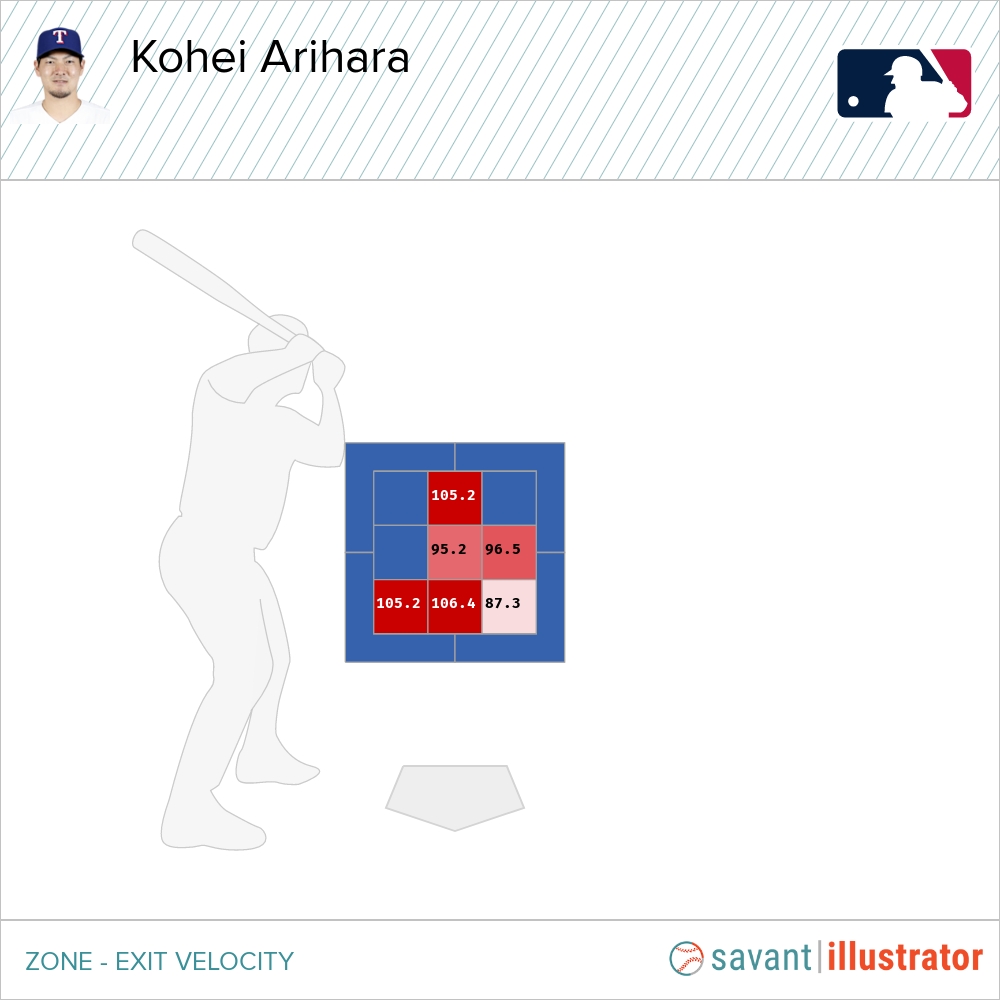
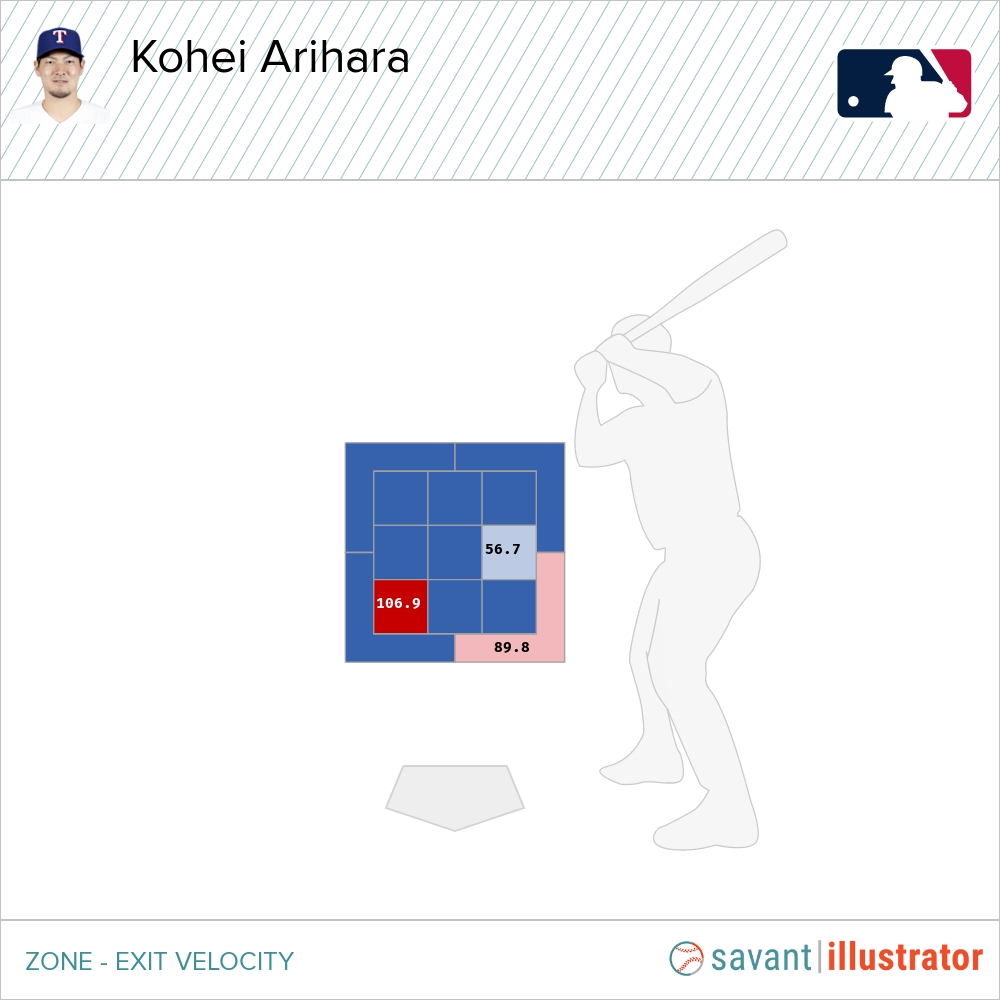
And it isn’t hard-hit balls beat into the ground either:
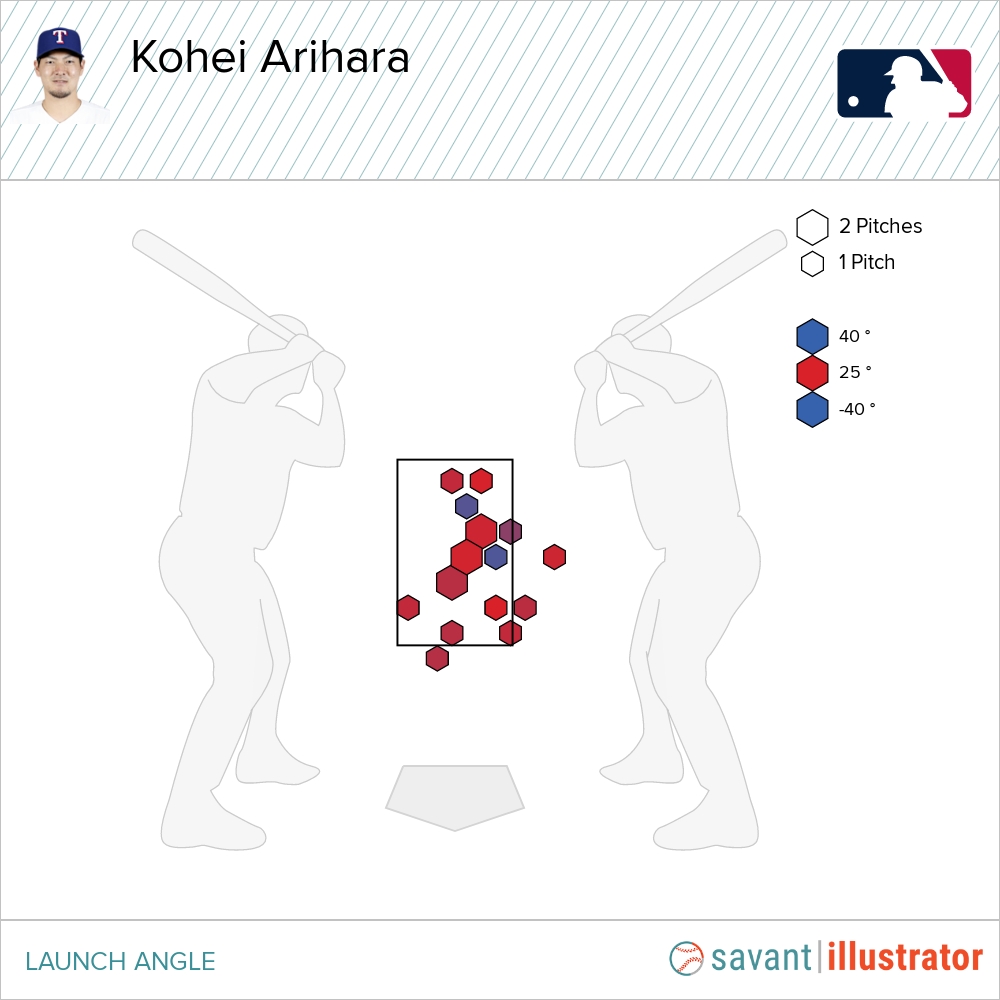
Up/down location doesn’t appear to have made much of a difference. Against San Diego, there was a concerted effort to keep the fastball down, but it yielded the same poor performance with an xSLG of .772. Arihara is clearly aware of the issue as he’s feeling out how to play this well below-average offering. Even though this pitch yielded decent results against the Angels, an xBA of .563 and xSLG of .811 point to luck being the cause. Arihara has fairly advanced control but despite doing a good job of keeping the fastball down and away from righties, it hasn’t mattered much and hitters aren’t chasing it either: (the first image is 4- seamers put in play, then total 4-seamers “in zone”)
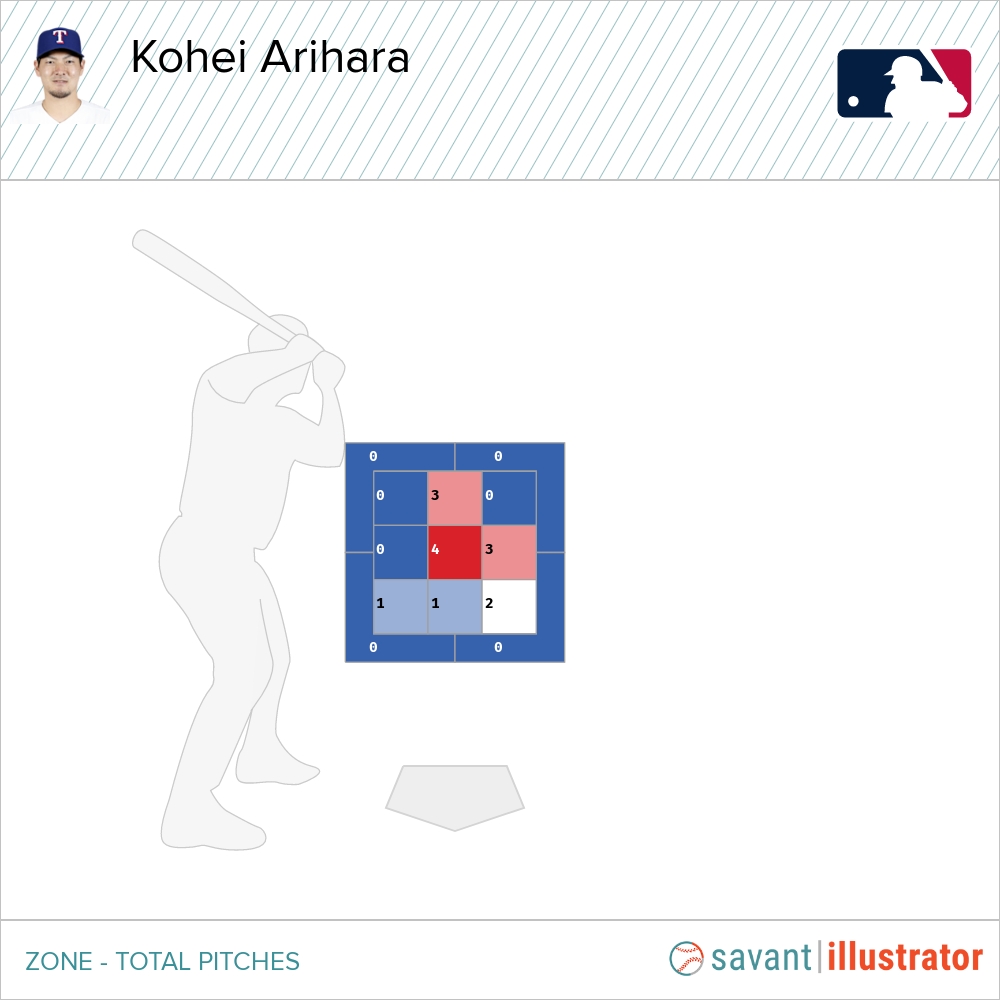
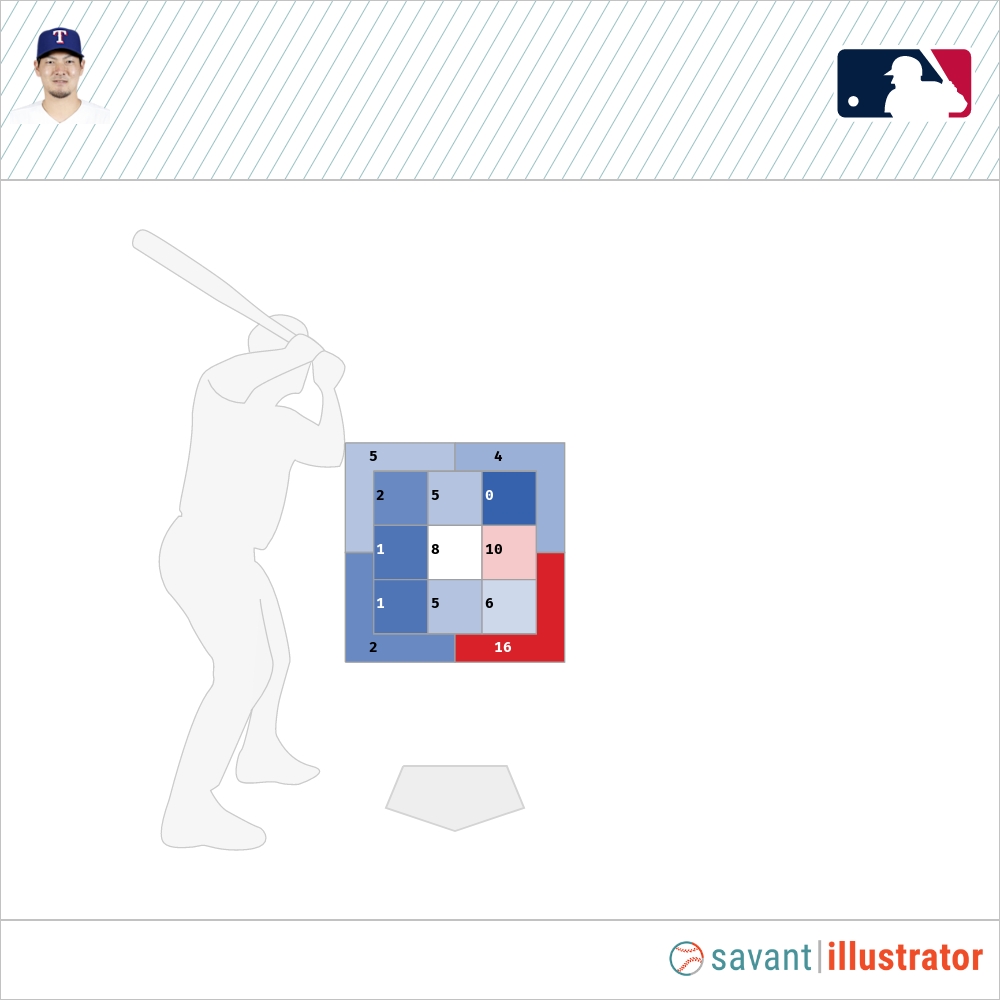
Getting the fastball to a passable grade against righties is going to be the key for Arihara. The underlying metrics point toward Arihara’s early results being more favorable to him than they should have been. Pretty much everything “expected” is higher than it’s played out, including home runs, as he’s surrendered two but his xHR was 4.1. It’s not all gloom though, as there are indications his “secondaries” can play well here.
Cutter
9.0% of offerings vs R / 21.8% vs L
29.8 CSW%
https://gfycat.com/unfinishedjampackedhawaiianmonkseal
Avg 87.3 mph – velocity and movement comp: Chris Bassitt (a little softer, a little more vertical movement)
|
Date |
# | # RHB | # LHB | % | MPH | H | 1B | 2B | 3B | HR | SO | BA | xBA | xSLG | xWOBA | EV | LA | Whiff% | PutAway% |
| @CWS | 15 | 7 | 8 | 21 | 85.9 | 3 | 2 | 0 | 0 | 1 | 0 | 0.600 | 0.364 | 1.023 | 0.562 | 97.200 | 22.000 | 16.7 | 0 |
| @LAA | 10 | 3 | 7 | 13 | 87.4 | 0 | 0 | 0 | 0 | 0 | 0 | 0.000 | 0.269 | 0.269 | 0.233 | 96.100 | -10.000 | 25 | 0 |
| @Tex | 12 | 2 | 10 | 14 | 88.3 | 0 | 0 | 0 | 0 | 0 | 0 | 0.000 | 0.294 | 0.667 | 0.394 | 93.900 | 3.000 | 16.7 | 0 |
| SD | 6 | 4 | 2 | 8.2 | 89 | 1 | 0 | 1 | 0 | 0 | 0 | 0.333 | 0.629 | 1.218 | 0.766 | 98.800 | 15.000 | 25 | |
| @KC | 14 | 2 | 12 | 19 | 88.4 | 1 | 1 | 0 | 0 | 0 | 0 | 0.250 | 0.114 | 0.12 | 0.107 | 76.300 | -11.000 | 11.1 | 0 |
As a possible alternative to the four-seamer, the cutter has been, meh.
Sinker/Two-Seam Fastball
14.6% of offerings vs R / 8.9% vs L
20.0 CSW%
I’m thinking Statcast is classifying two slightly different pitches under “sinker”. Arihara started throwing a two-seamer more in 2019 and as you can see in these two GIFs, the first looks like a sinker to me, and the second more like a two-seam, which the announcer even called such. I’m going to take the Statcast movement and velocity metrics with a grain of salt. It’s hard to take much away here other than it’s not a chase offering, not having been whiffed on yet, which is concerning for the possible two-seamer to lefties. The “sinker” as a classification is producing ground balls though as four of the six of them were put on the ground.
https://gfycat.com/dishonestalivebeagle
https://gfycat.com/familiarinsecureacornwoodpecker
Avg 90.4 mph / velocity and movement comp: Inconclusive
Slider
25.6% of offerings vs R / 10.1% vs L
26.1 CSW%
https://gfycat.com/leftsilentkudu
Avg 82.2 mph / velocity and movement comp: Dylan Bundy-ish
| Date | # | # RHB | # LHB | % | MPH | 1B | 2B | 3B | HR | SO | BA | xBA | xSLG | xWOBA | EV | LA | Whiff% | PutAway% |
| @CWS | 7 | 6 | 1 | 10 | 79.8 | 0 | 0 | 0 | 0 | 0 | Sacrifice | 0.666 | 96.9 | 25 | 0 | 0 | ||
| @LAA | 16 | 14 | 2 | 20.8 | 81.9 | 1 | 0 | 0 | 0 | 1 | 0.333 | 0.205 | 0.254 | 0.187 | 88.7 | 9 | 12.5 | 14.3 |
| @Tex | 14 | 12 | 2 | 16.5 | 83.1 | 0 | 0 | 0 | 0 | 1 | 0.000 | 0.113 | 0.118 | 0.102 | 93.8 | -37 | 33.3 | 20 |
| SD | 14 | 6 | 8 | 19.2 | 83.2 | 1 | 0 | 0 | 0 | 1 | 0.167 | 0.266 | 0.335 | 0.258 | 95.7 | -8 | 11.1 | 16.7 |
| @KC | 18 | 13 | 5 | 24.7 | 82.7 | 0 | 1 | 0 | 0 | 0 | 0.250 | 0.207 | 0.391 | 0.246 | 95.6 | 8 | 11.1 | 0 |
The slider hasn’t played horribly and is a pitch similar to Bundy’s in a vacuum, but that’s like judging chili by the beans alone. I can’t help but think the slider plays up with improved four-seam results, but this offering may have to be Arihara’s main weapon against righties and results have been OK thus far. It has been a decent little put away pitch against lefties, responsible for three of the fours strikeouts against them.
Changeup
2.5% of offerings vs R / 24.6% vs L
18.4 CSW%
https://gfycat.com/cavernousfamousblackbuck
Avg 82.2 mph / velocity and movement comp: Johnny Cueto with 2-3 more inches of arm-side run
The change is an attempted put-away pitch against lefties, but it’s only doing so at a 5% clip with a 27.8 Whiff%. The one above is a great pitch against Carlos Santana, but it’s been inconsistent, garnering a 20.0 GB% and accounting for only one of four strikeouts against lefties.
Splitter
12.6% of offerings vs R / 0.6% vs L
38.5 CSW%
https://gfycat.com/veneratedheftygoldenretriever
Avg 83.5 mph / velocity and movement comp: Kevin Gausman
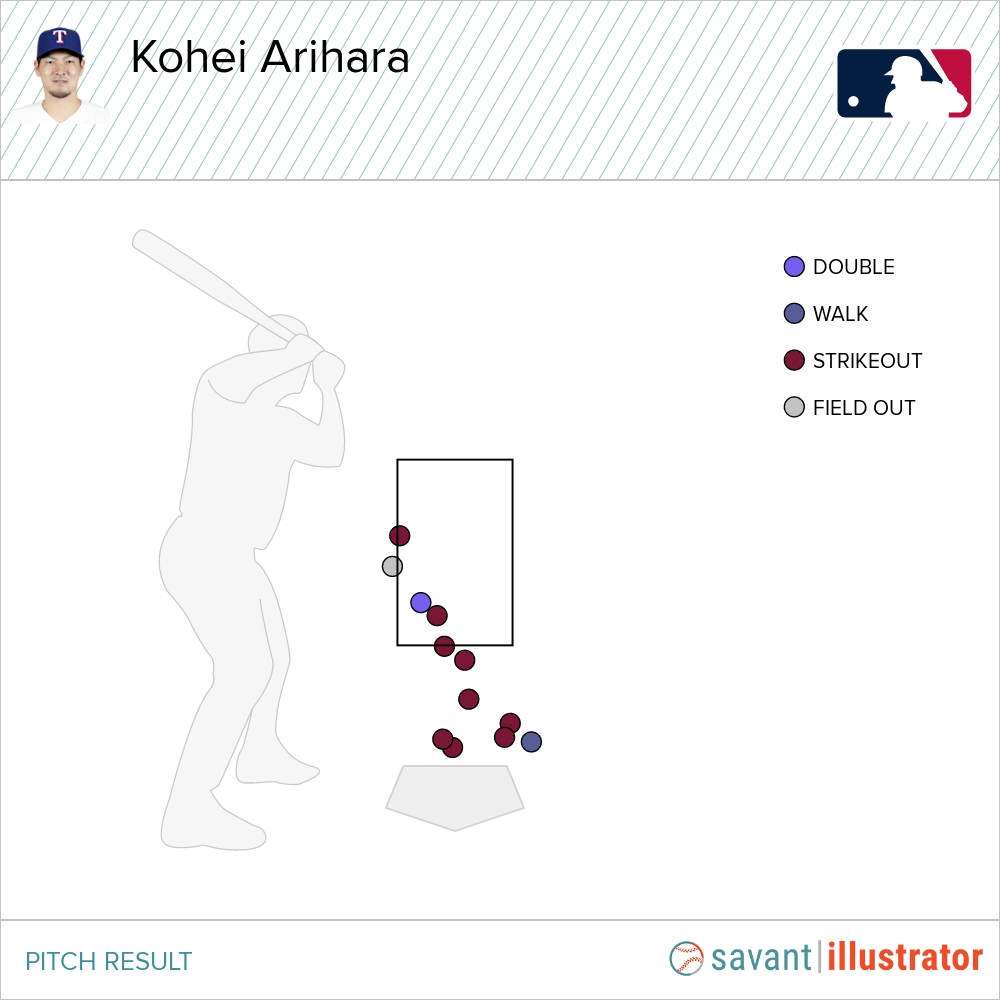
Arihara’s splitter is probably his best raw pitch, but the command isn’t the greatest. Getting the splitter down is fine, but too many don’t look like strikes long enough. The splitter has accounted for all nine of his strikeouts against righties.
Curveball
3.0% of offerings vs R / 1.7% vs L
0.0 CSW%
https://gfycat.com/caninekaleidoscopicconure
Avg 75.4 mph / velocity and movement comp: Craig Kimbrel minus 10 mph (Best I could do)
The curveball isn’t much of an MLB pitch and he can’t command it well. Against the White Sox, he tried to throw it in a tad more as things went south but it didn’t help. I don’t expect this to be anything more than a show-me pitch.
The arsenal as a whole:

Takeaway
The two scoreless outings got me excited, picking up a share as a possible stream and see speculation, but I’m not buying much of the two shutouts being a sustainable outcome at this point. With plus command, and a splitter proving to be a viable strikeout weapon against righties, I’m not completely out, but as we’ve seen, there are big warts. Going into his fifth start, I wondered if he’d be better served pitching out of the zone more, concerning himself less with free passes. He did throw out of the zone more in his fifth start, but the stuff and command weren’t there for him that day; his velocity was down with less action on secondaries and he couldn’t find the zone. I’m still curious if more out-of-the-zone offerings could bode well, but not in that fashion.
Anyone streaming Arihara should do so in desperation, as a blowup start feels like it’s lingering at any moment. Even during his ok starts, the wheels came off quickly. There are ingredients to be a successful big-league pitcher, but it’s a work in progress, and with continued fastball results like these, Yamaguchi’ing isn’t out of the range of outcomes.
In regards to FYPD retrospect, I think we did well as a whole assessing Arihara’s worth. I’ve probably overvalued the recent Japanese pros coming over of late, but part of that may be my propensity for large leagues whereupon any starter is hard to come by. In a 30 team points league, for instance, Arihara-types have considerable value and probably worth a more expensive cost, but in categories, we are probably right to fade an import with a questionable fastball. I’ll hold him on my bench for another start or two if needs don’t press a drop, but that’s probably a pretty optimistic move.
Photo by John Cordes/Icon Sportswire | Feature Graphic Designed by James Peterson (Follow @jhp_design714 on Instagram & Twitter)

